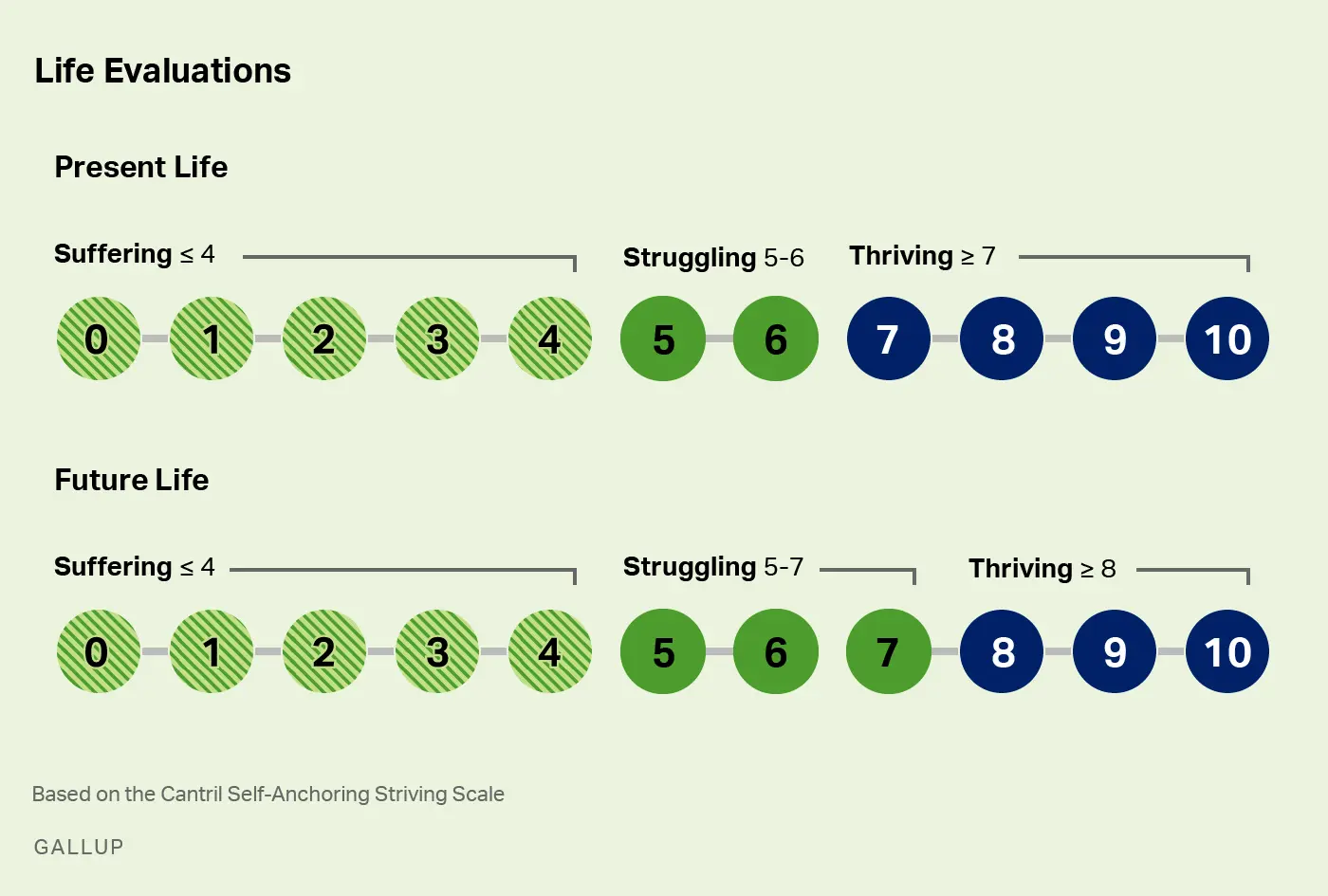Slack pings at 10 p.m.
Back-to-back meetings with cameras off.
High performing employees quietly checking out.
If these scenarios feel all too familiar, you're not alone. Many leaders are watching teams operate under constant pressure, with energy and focus slipping through the cracks.
The result? Missed goals, rising turnover, and a quiet undercurrent of fatigue that affects even high performers.
In this guide, we’re going to break down what employee wellbeing means and why it plays a central role in business outcomes. We’ll also explore 5 evidence-based strategies that help leaders take action, even in fast-paced or resource-strapped environments.
If you’re a HR or People leader who wants a long-term, practical approach (not one-off programs that lose steam in a few months), you’re in the right place.
What Is Employee Wellbeing?
According to Gallup, employee wellbeing encompasses five key elements:
- Career: Feeling engaged and having opportunities to do meaningful work
- Social: Having strong relationships and a sense of belonging
- Financial: Managing stress related to money
- Physical: Having the energy to get things done
- Community: Feeling connected to and supported by the broader environment
It reflects how employees experience their overall work life, including their sense of fulfillment, connection, growth, and stability. When these elements are effectively supported, employees demonstrate higher engagement, productivity, and resilience.
Unlike employee wellness, which typically focuses on physical health aspects such as nutrition, exercise, and sleep, wellbeing takes a more comprehensive approach to the human experience at work.
It captures not just physical health but the broader psychological, social, and economic factors that influence how people feel about and perform in their roles.
Why Employee Wellbeing Is Important
When wellbeing is supported, people are more likely to stay focused, show up consistently, and contribute with energy. Burnout, absenteeism, and turnover drop.
Wellbeing also supports the conditions that make high performance possible. Trust strengthens. Communication becomes clearer. Psychological safety grows.
Teams need more than tasks and timelines to thrive. They need to feel steady, valued, and supported in the work they do every day. Wellbeing creates that foundation.
How You Should Measure Employee Wellbeing

Wellbeing can feel hard to track, but it doesn’t have to be complex.
The Gallup Net Thriving Index offers one useful benchmark. It asks employees to rate their current and future life satisfaction on a scale, and classifies those responses into categories like “thriving” or “struggling”. It’s a helpful pulse on overall wellbeing.
A quick 0-10 scale can reveal important trends over time. Anonymous feedback also helps uncover what’s behind low scores, like workload, clarity, or stress levels.
Start by asking one of the following questions in your next 1-on-1:
- Career wellbeing: If 0 is no sense of purpose and 10 is deeply meaningful work, where would you place yourself right now? Where do you think you’ll stand one year from now?
- Social wellbeing: Thinking about your sense of connection with others at work, what step on the ladder would reflect how supported you feel? And where do you see yourself a year from now?
- Financial wellbeing: On a scale from 0 to 10, where 10 means full confidence in managing financial stress, where do you stand today? And where do you hope to be in a year?
- Physical wellbeing: How would you rate your energy and physical resilience during the workday? What step feels accurate for you? Where do you think you’ll be a year from now?
- Community wellbeing: When it comes to feeling a sense of belonging and value in your team or organization, what step would you choose? Where do you think you’ll be next year?
Then follow up with open-ended questions to understand where they’re coming from. Wear your coaching hat (not problem-solving hat) when having this conversation.
Based on their responses to these questions, people can fall into 3 groups:
- Thriving: People with positive views of their present life and of the next five years
- Struggling: People who struggle in their present life and have an uncertain or negative view of the future
- Suffering: People who report their life is miserable and have a negative view of the future
Using this simple two-part question, organizations can discover what percentage of their employees are thriving, struggling, or suffering, thus measuring their quality of life.

Source: https://www.gallup.com/workplace/404105/importance-of-employee-wellbeing.aspx.aspx
5 Ways to Improve Employee Wellbeing
1. De-stress the Nervous System
When stress takes over, the body kicks into survival mode. The vagus nerve, which connects the brain to key organs, plays a central role in regulating stress responses. When it's activated, the body shifts out of fight-or-flight and into a calmer, more focused state. Cortisol levels drop, breathing slows, and thinking gets clearer.
A few small habits can help teams calm their nervous systems, right in the middle of a busy workday.
Here are a few to try:
- Take 60 seconds at the start of a meeting to practice box breathing (inhale 4, hold 4, exhale 4, hold 4).
- During virtual calls, invite a neck roll or shoulder reset before diving in.
- Build stretch breaks into the rhythm of the workweek.
2. Coach, Don’t Just Manage
When leaders coach, they help people think for themselves. People feel more motivated when the ideas and solutions come from themselves, not from someone else telling them what to do.
One simple coaching tool is the GROW model:
- Goal: What do you want to achieve?
- Reality: What’s happening now?
- Options: What could you do?
- Will: What will you try?
Choose one person on your team and schedule a coaching-style conversation this month. Use the GROW model to guide it, keeping the focus on how they’re feeling, what they need, and what would help them move forward.
You don’t need to have the answers. You just need to create space for them to think. And over time, that space builds stronger, more resilient teams.
{{blogcta1="/style-guide"}}
3. Make Equity Operational
Equity affects how people feel at work. When things feel fair, people feel valued and supported. When they don’t, trust fades and wellbeing starts to slip.
To build a more equitable environment, focus on what can be seen and shifted. Here’s a simple framework to start:
- Acknowledge: Use anonymous pulse questions to surface patterns. For example: “Do you feel your voice is taken seriously on this team?” or “Have you had equal access to growth opportunities in the last six months?”
- Offer: Provide ongoing development options that go beyond high-potential programs. Shadowing, cross-training, or mentorship can create movement for people who feel overlooked.
- Track: Share progress openly. This might include representation in project leads, access to training, or feedback from engagement surveys. What’s tracked is taken seriously.
4. Have Meaningful Career Conversations

Career development is one of the strongest drivers of wellbeing. When people feel like they’re growing, they’re more engaged, focused, and likely to stay.
The key is to separate career conversations from performance reviews. When career conversations are tied to performance reviews, people often enter them guarded. The focus shifts to evaluation instead of exploration. That can make it harder to speak honestly about goals, strengths, or areas they want to grow.
Here’s a simple structure to follow:
- Ask long-term questions: “Where do you want to be in two years?” or “What kind of work do you want to do more of?”
- Set near-term goals: Identify one or two growth areas to focus on over the next few months. Keep it specific and doable.
- Follow up regularly: Check in on progress and look for ways to align current work with those goals.
Action tip: Block one hour this month to have a career conversation with each team member.
Even one thoughtful conversation can change how someone feels about their path and their place on the team.
5. Use Praise as a Performance Tool
Praise helps people see what they’re doing well. It builds confidence, boosts motivation, and shows the impact of their actions so they’re more likely to keep doing it.
Frequent, specific praise fuels performance. It tells people, “Keep going, this behavior matters”.
The Elevate 4-Point Praise Model is a simple way to do this well:
- Start with how you felt: “I was really impressed…”
- Name the behavior: “…by how you handled that difficult client conversation.”
- Share the impact: “It helped reset the tone and kept the project on track.”
- Give a quick thanks: “Thank you for stepping in with such clarity.”
Action tip: Pick one person on your team and praise them today.
Praise for effort, especially when tied to growth or resilience, leads to higher motivation and better results. It’s a small habit that creates lasting momentum.
Building a Culture Where People Thrive
Wellbeing is the foundation of business success. It makes or breaks the state of your employees.
This is the real work of culture. It shows up in how stress is managed, how praise is given, how careers are supported, and how people are treated when things get hard.
And most importantly, it doesn’t require a big budget. Just 3 things: consistency, intention, and action from the top.
What’s one small shift you can make this week that would help your team feel more steady, seen, or supported?







